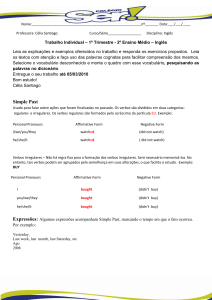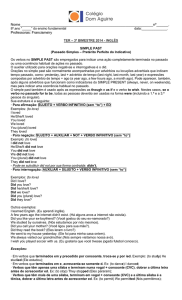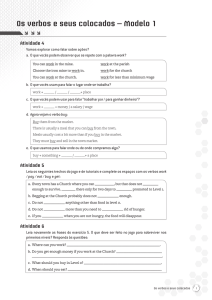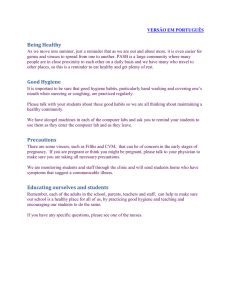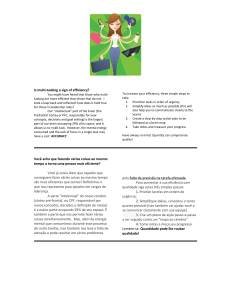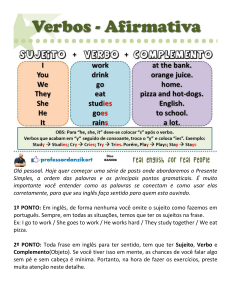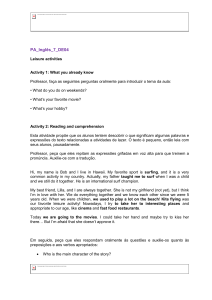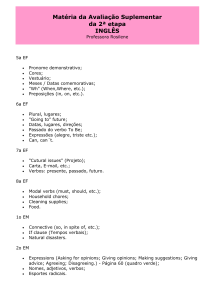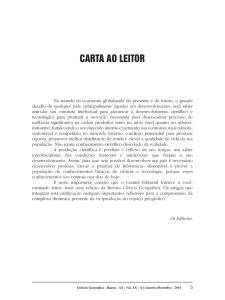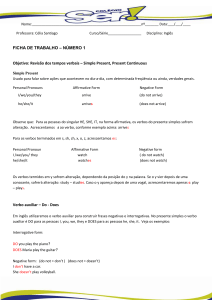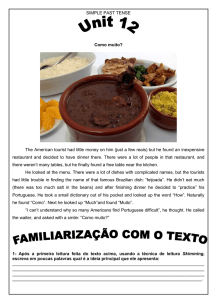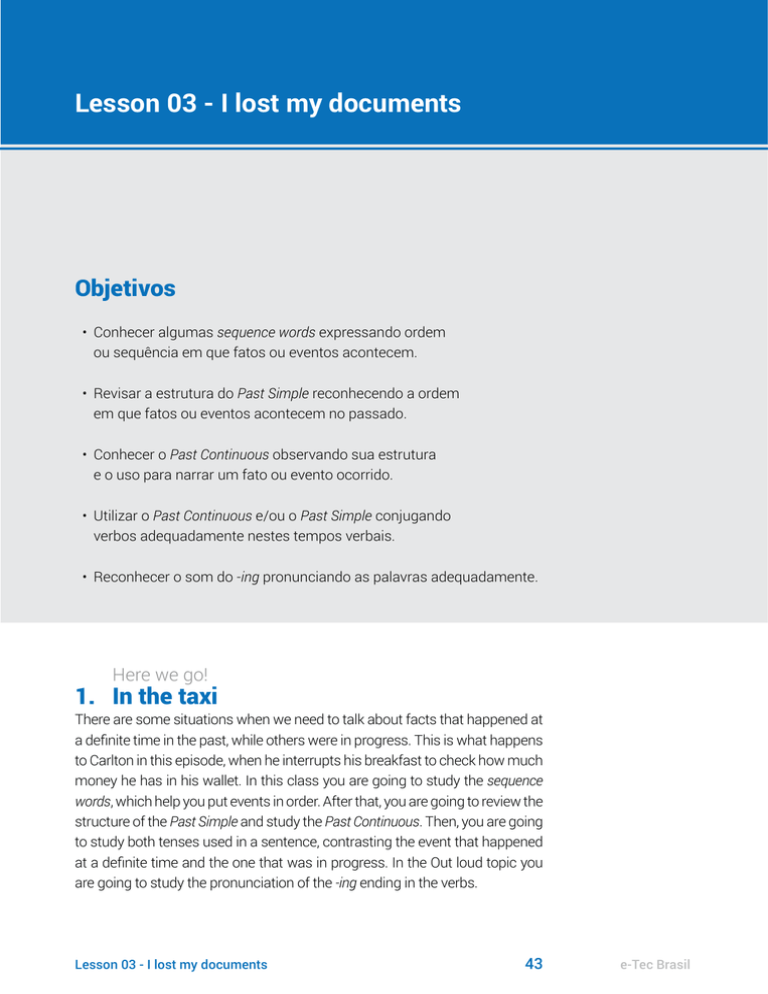
Lesson 03 - I lost my documents
Objetivos
• Conhecer algumas sequence words expressando ordem
ou sequência em que fatos ou eventos acontecem.
• Revisar a estrutura do Past Simple reconhecendo a ordem
em que fatos ou eventos acontecem no passado.
• Conhecer o Past Continuous observando sua estrutura
e o uso para narrar um fato ou evento ocorrido.
• Utilizar o Past Continuous e/ou o Past Simple conjugando
verbos adequadamente nestes tempos verbais.
• Reconhecer o som do -ing pronunciando as palavras adequadamente.
Here we go!
1. In the taxi
There are some situations when we need to talk about facts that happened at
a definite time in the past, while others were in progress. This is what happens
to Carlton in this episode, when he interrupts his breakfast to check how much
money he has in his wallet. In this class you are going to study the sequence
words, which help you put events in order. After that, you are going to review the
structure of the Past Simple and study the Past Continuous. Then, you are going
to study both tenses used in a sentence, contrasting the event that happened
at a definite time and the one that was in progress. In the Out loud topic you
are going to study the pronunciation of the -ing ending in the verbs.
Lesson 03 - I lost my documents
43
e-Tec Brasil
Warming up
2. Talking to the driver
Today is Carlton’s father’s funeral. He takes a taxicab to the Funeral Home,
but when he opens his backpack to the get his wallet, it is not there. Read
and listen to the conversation between Carlton and the taxi driver:
Taxi driver: It’s thirty-five dollars.
Carlton: I can’t find my wallet!
Taxi driver: Oh, really? Not again...
Integrated media
Acesse a mídia I lost my wallet
e acompanhe a conversa
entre Carlton e o taxista.
Carlton: I’m sure it’s here somewhere... wait a second... I was having breakfast
when I got it out to see how much money I had.
Taxi driver:Maybe it fell off your pocket when you got in the taxi?
Carlton: No, it was in my backpack.
Taxi driver: Once my wife and I were traveling by train and the same thing
happened. The next day the hotel called saying they had found my documents.
Maybe you left your wallet at the B&B?
Carlton: No, I'm sure I had it. I can't believe this is happening.
Getting on
Acesse o conteúdo Tips e veja
algumas dicas sobre o que fazer
em situações que perdemos
documentos importantes.
e-Tec Brasil
In this conversation, Carlton realizes that he lost his wallet. He briefly
recaps what happened during breakfast, trying to identify the moment
when he probably lost his wallet.
When we need to order events, we can use sequence words. In the next
topic you are going to study the most frequent sequence words.
44
English
3. Getting the hang of it
What’s the buzz?
Audio
3.1 Sequence words
As sequence words nos permitem organizar uma sequência de eventos.
Elas foram introduzidas na Lesson 09 e ampliadas na Lesson 14 do primeiro
módulo deste curso. Veja como algumas dessas palavras são utilizadas
para narrar o que aconteceu com Carlton:
First of all, Carlton was living in Chicago when he received a phone call from Sarah.
Secondly, he bought a ticket and flew to Canada. Then he met Bruno on the plane.
Later, when he was going to his father’s funeral, he realized he lost his wallet.
Getting on
Finally, Sarah helped him pay for the taxi fare.
A partir deste exemplo você pode perceber que as sequence words são
utilizadas para dar mais sentido ao texto, são palavras que nos permitem
colocar um evento em ordem cronológica. Elas podem indicar tempo,
ordem ou sequência de um acontecimento. Veja algumas destas palavras
na tabela a seguir:
First
Then
Before
First of all
While
During
To begin with
When
After
Secondly
Suddenly
By the end
Next
In the middle of the night
Finally
Soon after
Com estas sequence words é possível que você já consiga indicar a ordem
de alguns eventos. Pratique este conteúdo com a atividade Inserting
Sequence Words.
As Time Expressions foram
abordadas nas aulas 09 e 14
do Módulo 1. Acesse-as em:
Time expressions (presente)
Time expressions (passado)
Learning activity
Inserting Sequence Words
A seguir, acompanhe a retomada da estrutura do Past Simple, que lhe
permitirá narrar fatos ou eventos ocorridos no passado.
Lesson 03 - I lost my documents
45
e-Tec Brasil
3.2 Past Simple - review
Audio
Getting on
Na lesson 14 do Módulo 01, foi abordado o passado dos verbos To be e
There to be. Com estes conteúdos é possível que você consiga utilizar
estas estruturas para narrar eventos ocorridos no passado.
O Past Simple descreve ações que tiveram início e fim no passado, pois
tratam de eventos finitos. Os verbos no passado, na forma afirmativa, são
classificados em regulares e irregulares. Observe os exemplos:
Retome o conteúdo desenvolvido
no Módulo 1, acessando o
Past Simple - Verb To be
e Past Simple - Verb There to be.
I played a lot with my brothers and sisters in my childhood. (regular verb )
I had many health problems in the past. (irregular verb)
Os verbos regulares são acrescidos da terminação -ed:
Base form
Past simple
believe
believed
call
called
happen
happened
travel
traveled
wait
waited
Perceba que o verbo believe já termina com “e”, por isso foi apenas acrescido
da letra “d” para formar o passado. Veja outros exemplos:
e-Tec Brasil
46
Base form
Past simple
hate
hated
like
liked
move
moved
English
Os verbos terminados em “y” precedidos por vogal são também acrescidos
da terminação -ed:
Audio
Base form
Past simple
play
played
stay
stayed
Já os verbos terminados em “y” precedido por consoante têm o “y”
substituído por “i”, para então serem acrescidos da terminação -ed:
Base form
Past simple
bury
buried
study
studied
Verbos como To be, To have, e To go, não aceitam a inserção da terminação
-ed por serem verbos irregulares. Assim, são conjugados de forma
diferenciada. Observe:
Base form
Past simple
To be
was, were
To have
had
To go
went
Getting on
Os Irregular Verbs foram
abordados na aula 15 do
Módulo 1. Acesse-os em:
Past simple - Affirmative
form: irregular verbs
As sentenças negativas se estruturam com o auxiliar did acrescido da
partícula not (did not; didn’t):
I didn’t play videogames when I was a child.
They didn’t have any questions about the test.
Lesson 03 - I lost my documents
47
e-Tec Brasil
As yes-no questions e short answers são formadas com o uso do auxiliar did:
Audio
Yes-no questions
Affirmative
short answers
Negative
short answers
Did you go to the
beach last weekend?
Yes, I did.
No, I didn’t.
Did they watch that
new movie?
Yes, they did.
No, they didn’t.
Quando houver uma wh-question, é o pronome interrogativo que inicia
a pergunta:
What did you eat yesterday at dinner time ?
Where did he go this morning?
Who did they meet at the party?
Learning activity
Sequence in the Past
Talking about losing documents
Conforme apresentado, o Past Simple relata ações realizadas em um tempo
determinado no passado, ações que já terminaram. Neste momento é
importante que você verifique sua aprendizagem realizando a atividade
Sequence in the Past and Talking about losing documents.
No tópico a seguir você estudará o Past Continuous, que indica um evento
em andamento em um determinado período de tempo no passado.
e-Tec Brasil
48
English
3.3 Past Continuous - structure and use
Na situação apresentada anteriormente, Carlton não consegue encontrar
sua carteira para pagar o valor do percurso que o táxi realizou. Ao explicar
sua situação para o taxista, ele relata o que estava fazendo quando viu sua
carteira pela última vez, e para isso utilizou o Past Continuous. Observe:
Audio
Carlton: I was having breakfast when I got it out to see how much money I had.
O Past Continuous é utilizado para falar de algo que estava acontecendo, ou
seja, uma ação em andamento no passado. Nesta frase, pode-se observar
a estrutura que compõe o Past Continuous:
Subject
Complement
I was having Breakfast.
Verb To be (past)
Main verb + ing
Veja outros exemplos a seguir:
I was preparing lessons.
You were traveling last week.
He was listening to music.
She was reading a book.
It was raining last week.
We were studying English.
Lesson 03 - I lost my documents
49
e-Tec Brasil
You were discussing important topics.
They were watching TV .
Audio
As frases negativas são formadas com o auxiliar do verbo To be no
passado (was ou were) acrescido da partícula not. O verbo To be na forma
negativa pode ser escrito por extenso (was not ou were not) ou de forma
contraída (wasn’t ou weren’t).
Subject
Complement
I wasn’t having Breakfast.
Verb To be (past)
Main verb + ing
Observe que nas frases a seguir foram utilizadas as formas contraídas:
I wasn’t preparing lessons.
You weren’t traveling last week.
He wasn’t listening to music.
She wasn’t reading a book.
It wasn’t raining last week.
We weren’t studying English.
You weren’t discussing important topics.
They weren’t watching TV.
Já a forma interrogativa é formada fazendo-se a inversão do Verb To be no
passado com o sujeito da frase:
Subject
Complement
Was I having Breakfast?
Verb To be (past)
Main verb + ing
Acompanhe outros exemplos:
Was I preparing lessons ?
Were you traveling last week?
e-Tec Brasil
50
English
Was he listening to music?
Was she reading a book?
Audio
Was it raining last week?
Were we studying English?
Were you discussing important topics?
Were they watching TV?
Para se responder utilizando as short answers é empregado o Verb To be no
passado com o sujeito da pergunta. Confira alguns exemplos:
Yes-no questions
Affirmative
Short answers
Negative
Short answers
Were you traveling
last week?
Yes, I was.
No, I wasn’t .
Was Carlton looking
for his wallet?
Yes, he was.
No, he wasn’t.
Were they watching TV?
Yes, they were.
No, they weren’t.
Também podemos fazer perguntas utilizando as Wh-questions. Para isso,
lembre-se que é preciso fazer a inversão Verb To be - subject e adicionar as
wh - questions no início da frase. Veja:
Jack
What were you doing yesterday morning ?
Jill
I was having a picnic at the beach.
Lesson 03 - I lost my documents
51
e-Tec Brasil
Audio
No exemplo anterior foi utilizado uma Time expression (yesterday morning)
que pode ser utilizada em diferentes situações com diferentes tempos
verbais. Este conteúdo já foi estudado na Lesson 14 do Módulo 01, assim
serão retomadas algumas dessas Time expressions associadas ao Past
Simple ou ao Past Continuous.
Yesterday
A month ago
The day before yesterday
Last night
A year ago
Last year
Last month
Two hours ago
Last week
Last hour
A week ago
Last semester
Last Tuesday
Earlier today
The last time
Veja outros exemplos de perguntas utilizando Time expressions:
Learning activity
Jack
Where were you working last summer?
Jill
I was working at a restaurant.
Jack
Who was he talking to on the phone last night ?
Jill
Bruno, his new friend.
A partir deste conteúdo você poderá conjugar verbos no passado e falar
sobre o momento em que as ações aconteceram. Para verificar se você
compreendeu esse conteúdo, realize a atividade Uses of Past Continuous.
Uses of Past Continuous
No tópico seguinte você estudará o contraste entre estes dois tempos
verbais no passado: Past Continuous vs. Past Simple. Você poderá
observar a diferença que existe entre um e outro em relação às ações no
passado, àquelas que estão em andamento e aquelas já terminadas.
e-Tec Brasil
52
English
3.4 Past Continuous vs. Past Simple
O Past Continuous é utilizado juntamente com o Past Simple para expressar
uma ação que estava em andamento e foi interrompida. No episódio desta
aula, Carlton conta sobre o momento em que para de tomar seu café da
manhã para ver quanto dinheiro ele tinha na carteira.
Observe o uso da conjunção de tempo when, que marca o momento em
que Carlton interrompe seu café para pegar a carteira:
I was having breakfast when I got it out to see how much money I had.
Ação em andamento
Interrupção
Para mostrar-se solidário com o rapaz, o taxista que leva Carlton até a
funerária conta sobre algo semelhante lhe aconteceu:
Once my wife and I were traveling by train and the same thing happened.
Ação em andamento
Interrupção
Ao final do episódio, a recepcionista da B&B ligou para Carlton, avisando
que a carteira foi encontrada. Veja o que ela disse:
The kitchen staff was cleaning the tables when they found your wallet.
Ação em andamento
Interrupção
Assim como when, podemos utilizar a conjunção de tempo while, que
também serve para indicar que algo aconteceu enquanto uma ação estava
em andamento:
They went to the supermarket while I was studying.
While we were playing outside it started to rain.
Lesson 03 - I lost my documents
53
e-Tec Brasil
Audio
Como você deve ter percebido, as frases afirmativas podem iniciar com o
Present Continuous ou com o Past Simple, sem alteração de sentido. Veja
outros exemplos:
AFFIRMATIVE SENTENCES
Past Continuous - Past Simple
Past Simple - Past Continuous
I was working at home when
the lights went out.
The lights went out when I
was working at home .
While she was living abroad her
friend had a heart attack.
Her friend had a heart attack
while she was living abroad.
Para formar frases negativas que contêm Past Continuous e Past Simple,
elas também podem iniciar com o Past Continuous ou com o Past Simple,
sem que haja alteração no sentido. Acompanhe a tabela:
NEGATIVE SENTENCES
Past Continuous - Past Simple
Past Simple - Past Continuous
I wasn’t sleeping when the phone rang.
When the phone rang I wasn’t sleeping.
She wasn’t thinking straight
when she said that.
When she said that she
wasn’t thinking straight.
A forma interrogativa das yes-no questions é feita a partir da inversão do
verb To be com o sujeito. Para responder a essas perguntas, você poderá
utilizar as short answers, que são compostas pelo sujeito da frase e o verb
To be. Observe:
e-Tec Brasil
Yes-no
questions
Affirmative
short answers
Negative
short answers
Were you driving fast when
the police stopped you?
Yes, I was.
No, I wasn’t.
Was he working when you called him?
Yes, he was.
No, he wasn’t.
54
English
Quando houver uma Wh-question, é importante ressaltar que esse pronome
interrogativo deverá iniciar a pergunta:
Audio
What were you doing yesterday when they arrived?
Why was she buying a new dress?
Who were they talking to on the street?
Where was he going?
Após estudar a diferença entre Past Simple e Past Continuous, pratique este
conteúdo realizando as atividades Bruno’s routine, Routine in the past e Word
order and Past tenses.
No tópico a seguir você estudará a pronúncia da terminação -ing dos
verbos, o que contribuirá para as suas habilidades de listening e speaking.
Learning activity
Bruno’s routine
Routine in the past
Word order and Past tenses
Out loud
3.5 -Ing ending
A terminação -ing dos verbos é pronunciada de forma suave, omitindo-se
a letra “g” ao falar. Escute alguns exemplos:
working
thinking
sleeping
driving
Agora escute a pronúncia dos verbos terminados em -ing nas frases:
I was working at home when the lights went out .
I wasn’t sleeping when the phone rang.
She wasn’t thinking straight when she said that.
Were you driving fast when the police stopped you?
Lesson 03 - I lost my documents
55
e-Tec Brasil
Escute agora o verbo terminado em -ing e a palavra seguinte, neste caso,
a preposição at:
working at
Audio
working at
Perceba que a terminação -ing junta-se à palavra seguinte, quando esta
inicia com vogal, formando uma palavra apenas. Escute:
I was working at home when the lights went out.
I was working at home when the lights went out.
Escute outros exemplos:
He was studying every day for his test.
He was studying every day for his test.
They were dancing in high heels to practice for the wedding.
They were dancing in high heels to practice for the wedding.
Depois de estudar a pronúncia dos verbos terminados em -ing, realize a
atividade -ing ending sounds para praticar e consolidar sua pronúncia.
Learning activity
-ing ending sounds
e-Tec Brasil
56
English
Catching a glimpse
4. Canadian documents
The SIN (Social Insurance Number) is an important document in Canada,
which serves as a national identification number, similar to the Social
Security Number in the USA. In order to apply for a SIN, the applicant needs
to have his original identity documents, photocopies are not acceptable.
Nowadays you need it to work in Canada or to have access to government
programs and benefits. For people who want to work or study in the
country, the primary documents are:
Integrated media
Acesse a mídia Canadian
documents para escutar
este texto.
Work permit: provided by the Citizenship and Immigration Canada (CIC).
The applicant will receive a letter confirming if a temporary SIN was
provided. If so, this SIN will start with the number “9” and the expiration
date will vary according to his field of activity.
Study permit: provided by the CIC. The foreign students must present
either only a study permit or a study permit plus a letter provided by the
CIC stating that they can work.
If the student does not fulfil these requirements, he can contact the CIC
and apply for the study permit.
All the temporary applications for studies, work or visit in Canada should be
submitted online or through the Visa Application Centre (VAC) in London.
Lesson 03 - I lost my documents
57
e-Tec Brasil
5. That’s a wrap!
In this lesson the episode shows Carlton going to his father’s funeral. When he
arrived at the funeral home, he realized he had lost his wallet. Sarah welcomed
him and offered to help, but actually she asked Jason to pay for the taxi fare.
You studied the sequence words, used to put events in order. You reviewed
the structure of the Past Simple, which is used to talk about events that
happened at a definite time in the past. After that, you studied the structure
of the Past Continuous, which refers to events that were in progress in the
past. You also studied both Past Simple and Past Continuous, to express an
action in progress in the past and the event that interrupted it. Finally, you
studied the pronunciation of the -ing ending in the gerund form.
It is important that you feel confident to use the structures you worked with
here. Best of luck in the next lesson!
e-Tec Brasil
58
English

